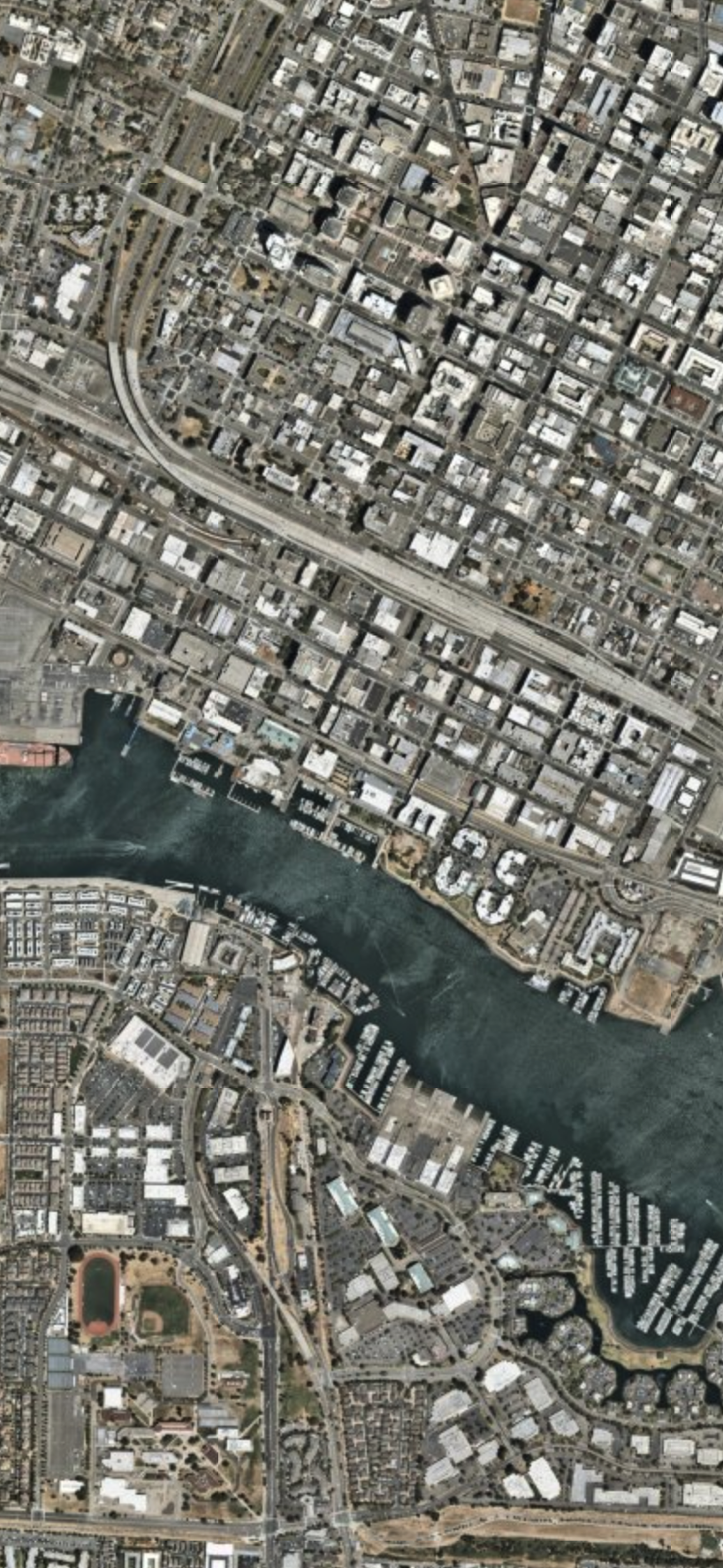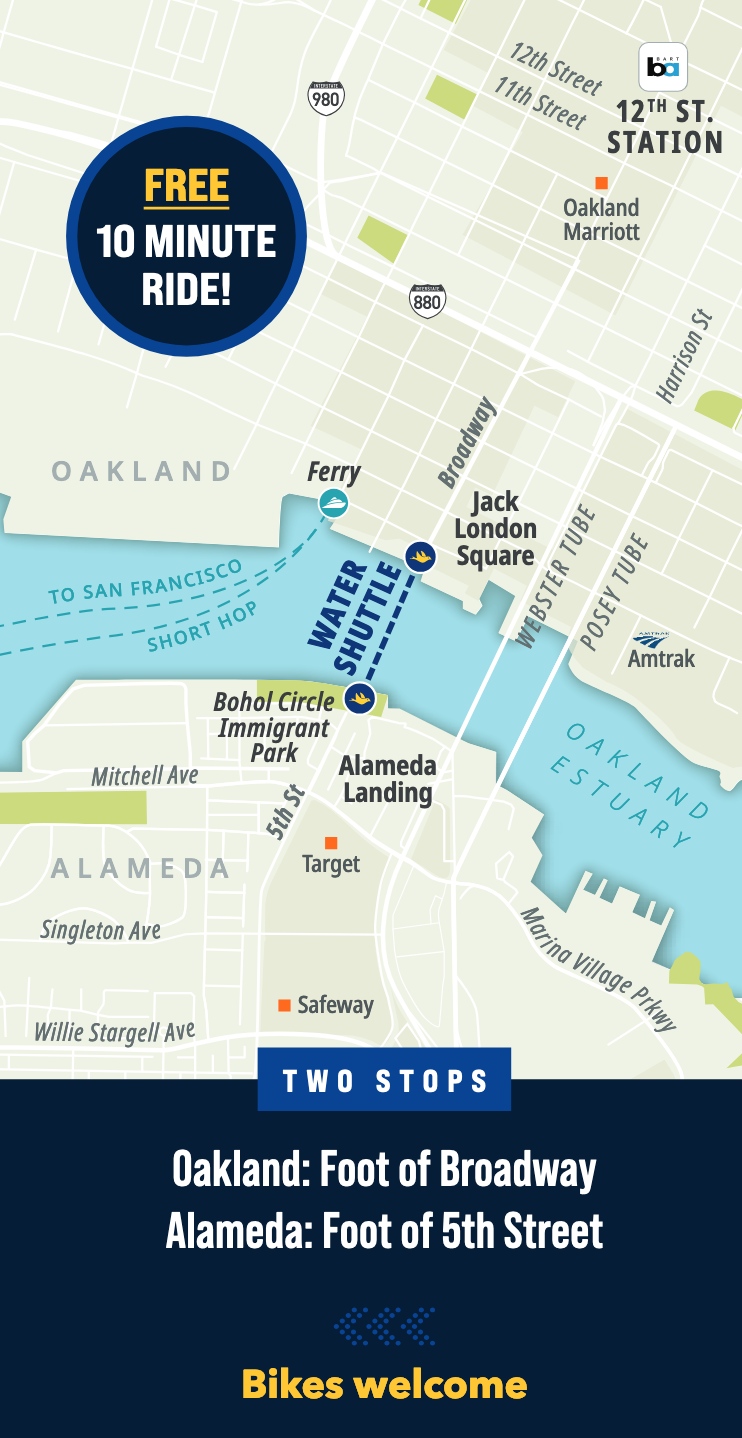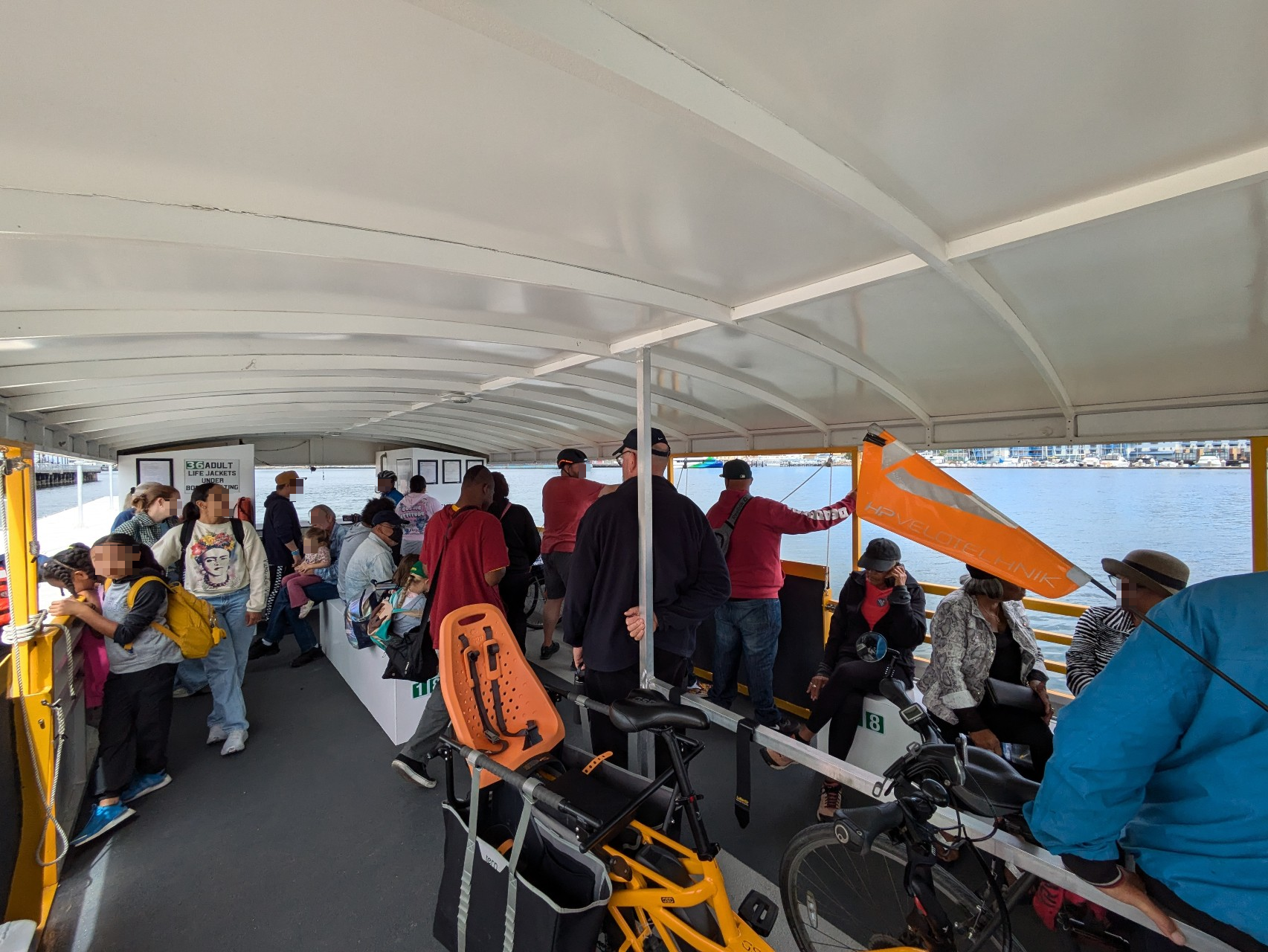This Wednesday, at 11:05 a.m. I joined about 30 other people and some of their bicycles (plus an adult-sized tricycle) on the first day's journey of an "MVP."
An MVP, in the parlance of SiliValley, is a minimally viable product — a means of testing a market's interest in a new product offering.
The target of this physical MVP that ~30 folks and I stepped aboard: the market of people traveling between the west side of Alameda and the central business district of Oakland, along the Broadway/Webster corridor.
This corridor just so happens to be bisected by water, so to serve this market of travelers, each product offering has to go over — or under — the water.

The incumbent offering
There is an incumbent player serving this market. This legacy incumbent is massive (with an annual organizational budget of around $20 billion and approximately 20,000 employees) and they are currently allocating $150 million toward expanding their product offering for this particular market. The incumbent is so sure of its footing in this market that it uses its funds to subsidizes the entire cost of this particular product offering for this particular corridor — so the incumbent's customers can use this product for free as often as they wish!
But the incumbent only cares about a certain type of customer: Their target customers are the drivers of motor vehicles. The incumbent (aka Caltrans) moves drivers along this corridor through two tubes. Customers on foot or on bicycle are officially welcome to also travel for free through one of the tubes. To quote one such customer about the journey along the Broadway/Webster corridor by bike or foot:
This journey always starts with a very hard decision.
Maybe you’re late for a work meeting with the boss. Maybe you need to pick your kid up at a daycare that charges $5 every minute you’re late. Or maybe you simply grab your bike, look into the absurdly narrow chasm of the Posey Tube’s bike/pedestrian sidewalk, and think, “It couldn’t be that bad.”
But alas, it is that bad.
[...]
The harrowing ride might save 40 minutes or more, and yet during that 0.7-mile shortcut you’re bombarded with eerie sights, sketchy encounters, noise pollution, pollution pollution, a complete divorce from sunlight and a very real chance you’ll catch a handlebar on the railing and slam against a tile wall painted black by the grimy exhaust of 10,000 cars.
— "This is the Bay Area’s most harrowing bike ride. Is it about to be history?" by Peter Hartlaub, a long-time San Francisco Chronicle writer (and an Alameda resident)
This market clearly has potential customers with unmet needs.
A new alternative for a wider range of riders
And thus, the MVP: a boat to take those on foot or bike across the water, so they can complete their larger journeys through this corridor:

Just as some startups realize that creating their MVP will require so much more than just a user interface to "delight" their users, behind the scenes this MVP has required forms and partnerships and approvals and timelines and contracts and lawyers. (I wrote previously about the collaborative partnerships between the City of Alameda and other public agencies and NGOs.) Last summer, a smaller attempt at an MVP was canceled when that boat was deemed to not be fully up to ADA accessibility requirements. The "minimum" of this MVP turns out to actually be quite substantive in terms of staff time, creativity, and partnerships forged.
But that's all beside the point now. The MVP exists! Real people are using the real MVP to accomplish their journeys along this corridor, reach their destinations, and accomplish their ultimate goals without an automobile:

As I've chatted with folks in person and online about the Water Shuttle, the limitations of the MVP quickly come up: Why doesn't it run on Monday or Tuesday? Couldn't it run later on evenings? Why do you have to wait for the boat at all; shouldn't it leave whenever a sufficient crowd has assembled? Shouldn't there be two boats so you don't have to wait as long and so there's back-up in case one boat breaks? (For even more questions about limitations, see a blog post on Streetsblog SF.)
These are all valid questions and valid requests. (Indeed, the boat did unexpectedly need repairs near the end of Wednesday. It was out of service on Thursday; it's running again this [Friday] morning. To learn about any future service disruptions, you can subscribe for email or SMS alerts.)
But here's why I'm using the SiliValley framing of "MVP" so repeatedly about the Water Shuttle: The reason why we're all able to make these requests to improve the service is because something now exists.
The something of the Water Shuttle is a viable alternative to the auto-only incumbent. It's a way of showing that there's a much wider set of people who want to travel this corridor. My Wednesday 11:05 a.m. trip included some families with kids; a group of seniors; a group of adults with special needs; an older Alameda resident with a tricycle; a couple of cyclists who looked dressed for a professional office; a man with a guitar in a case. Folks of all ages and racial backgrounds were there, and if I can guess based on clothing, a range of income levels were represented. I would also guess that the travelers on my boat trip also had a wide range of goals: some just there for an outing (a fun optional trip), some trying to reach an office that day (a necessary trip), and some evaluating the water taxi for their own future use (perhaps all of the above). I chatted with a couple, but hardly all, of the people onboard.
I share these guesses not to characterize the exact people traveling with me — but rather to say that this is what the MVP enables. The MVP now enables the City of Alameda and its partners to systematically measure usage and to survey riders for more context about their personal characteristics and their personal goals.
Per the city, on the first day of service on Wednesday: "More than 775 passengers crossed the Estuary by boat instead of in a vehicle, along with 183 bicycles."
Experiments
And based on these findings about actual real-world usage, the MVP enables the partners to experiment.
Are some days or times more popular with riders? Are some days or times unpopular? Do a significant number of feedback-givers keep asking for an expanded schedule to support a specific type of journey? The schedule can and likely will be adjusted over the course of the two-year pilot:

There are limits to the experimental possibilities: The two-year-long pilot budget allows for a certain number of "service hours" (when the boat is staffed, fueled, and operational). And the nature of operating the boat does require some regularly scheduled down-time when crews change shifts (or get a break to go to the bathroom) and when the boat is re-fueled. There is only one boat.
Still, there's sufficient room to experiment within these constraints during the two-year pilot:
- Will the Water Taxi become an evening outing for diners and revelers?
- Will it be a day-time commute for office-goers?
- Will it be a mid-day outing for seniors and families with young kids?
- Are there other sets of customers we haven't even thought about here?
By measuring usage, surveying riders and collecting feedback, and experimenting with the schedule, the Water Shuttle partners will be able to systematically answer these sorts of questions — and to also improve the MVP to even better meet the needs of actual riders and potential riders.
Prospects: Long-term
The City of Alameda and its partners have a long-term vision for what this MVP can become: an estuary bridge.
The bridge will enable pedestrians and cyclists to traverse the watery gap of the Broadway/Webster corridor 24 hours a day, 7 days a week. No need to make scheduling trade-offs between commuters cycling to an office on Monday at 8:30 a.m. and revelers on Friday at 10:30 p.m. returning from a drink in Jack London Square or at Alameda Point.
If the $100 million to $200 million (with an "m") estimated price for the estuary crossing bridge scares you, let's put it into context:
- Caltrans is already spending $150 million just on changing the entry ramps that lead to and from the tubes. Did you see any scary headlines in the San Francisco Chronicle when that project went over budget before even breaking ground? Nah, the Alameda County Transportation Commission just quietly covered the extra $20 million:

- The Bipartisan Infrastructure Law has allocated $1.2 trillion (with a "t" dollars) to infrastructure improvements nation-wide. (Compare that "t" dollars to the "m" dollars required for the estuary bridge.) That's just one of many pots of external funds for which Alameda and Oakland will complete to use to fund the bridge.
- All work to date on planning for the bridge has been secured from grants from Alameda County. General funds from the City of Alameda have not been needed to move the bridge plans forward. Having the estuary crossing bridge as a "shovel ready" project means that Alameda and Oakland will be ready to apply for any and all federal funds. There are no other similarly sized transportation projects in the pipeline in Alameda. This our collective way to get a big chunk of federal funds to improve live in the inner East Bay.
- And here's one other order-of-magnitude to keep in mind for context: The new eastern span of the Bay Bridge cost $6.5 billion (with "b") to construct. Last year's headline in the SF Chronicle reading "A $200 million bike bridge tantalized this Bay Area city. It may never get built" implicitly hinged upon a comparison between the estuary crossing bridge (with its "m" cost) and the Bay Bridge (with its "b" cost). Yes, it's true that many infrastructure projects in the US go over-budget, and that may very well happen to the estuary bridge. But comparisons with the Bay Bridge are not valid — that is such a massively larger bridge in physical scale, needs, and in its billion-with-a-b budget. While I try not to disagree with named individuals who are not elected officials on this blog, I think it's reasonable to question Randy Rentschler's pronouncements about the estuary bridge when he served on the Alameda city Transportation Commission and when he spoke with the Chronicle reporter for that story. I don't question his expertise on the Bay Bridge project (which I believe he officially represented as MTC's lead spokesperson), but I do not think it's wise or useful to directly take the challenges of the Bay Bridge and use them as a tacit reason to dismiss out of hand the estuary crossing project.
- The cost of the estuary crossing will be mainly driven by the height of the bridge, and the height will be mainly driven by the US Coast Guard's requirements. So instead of worrying about hypothetical costs, it's most productive for the City of Alameda and its partners — and every interested travelers of this corridor — to make sure the US Coast Guard hears how important it is to get the bridge planning right.
Prospects: medium-term
This 5-day-a-week MVP of the Water Shuttle pilot is a small but real step toward a 24/7 bridge. It's demonstrating the need — the market opportunity — and it's helping to bring together organizations and stakeholders and everyday people who will all benefit from bridging this gap between Oakland and Alameda.
This pilot is also an opportunity to demonstrate the potential for a more full-featured shuttle system over the next few years. Is there sufficient demand to buy a second boat? Is there sufficient demand to fund this program for two additional years (or maybe even 5 or 10 additional years)? Let's find out!
While I'm very open to hearing comments from readers below, please also send your feedback (positive and/or constructive) directly to the Water Shuttle team. Here is their feedback form: https://us.openforms.com/Form/b43e3332-d991-4c44-8af2-190a7a73d54a (of it that link changes in the future, go to the Water Shuttle website and look for the "feedback" link)